Recognizing Significant Components of Electrical Waveforms of Actuators Operated by Vehicle Controllers
Abstract
1. Introduction
1.1. Analysis of the State-of-the-Art in Testing Fuel Injectors and Engines
1.2. Basis for Conducting Research and Its Scope
2. Methodology
- Research goalTo develop a program for the automatic calculation of the characteristics of the current signals of injectors.
- Investigated objectFuel injector of the internal combustion engine.
- Scope of research
- (a)
- Defining the basic components of the characteristics of electric current waveforms occurring during the operation of internal combustion engine fuel injectors as well as evaluating the possibility of their use in the analysis of the operation and technical condition. The research will be conducted on the basis of the literature analysis and the results of the authors’ research work presented in other publications.
- (b)
- Adoption of computational assumptions and the analysis of mathematical relationships required to develop the algorithm of the computational program for processing recorded electrical signals and determining the relevant information. On the basis of the analysis to be carried out, the dependencies will be selected, which enable the extraction of the characteristics of current signals, forming the basis for further scientific research.
- (c)
- Development of a computational program for determining and analyzing the required values of the recorded current signals of fuel injectors, along with a method for presenting the results. An assumption was made that the program should allow for clear implementation of the selected mathematical dependencies as well as the rapid calculation of current signals and the visualization of test results in the form of a graph and in a table.
- (d)
- Testing of the developed computational program on the basis of previously recorded current signals of fuel injectors as well as presentation of the sample test results. These tests will be conducted for injectors operating at different engine speeds and with different loads.
- (e)
- Discussion of the research conducted and the results obtained.
3. Characteristic Values of the Electric Current Waveform
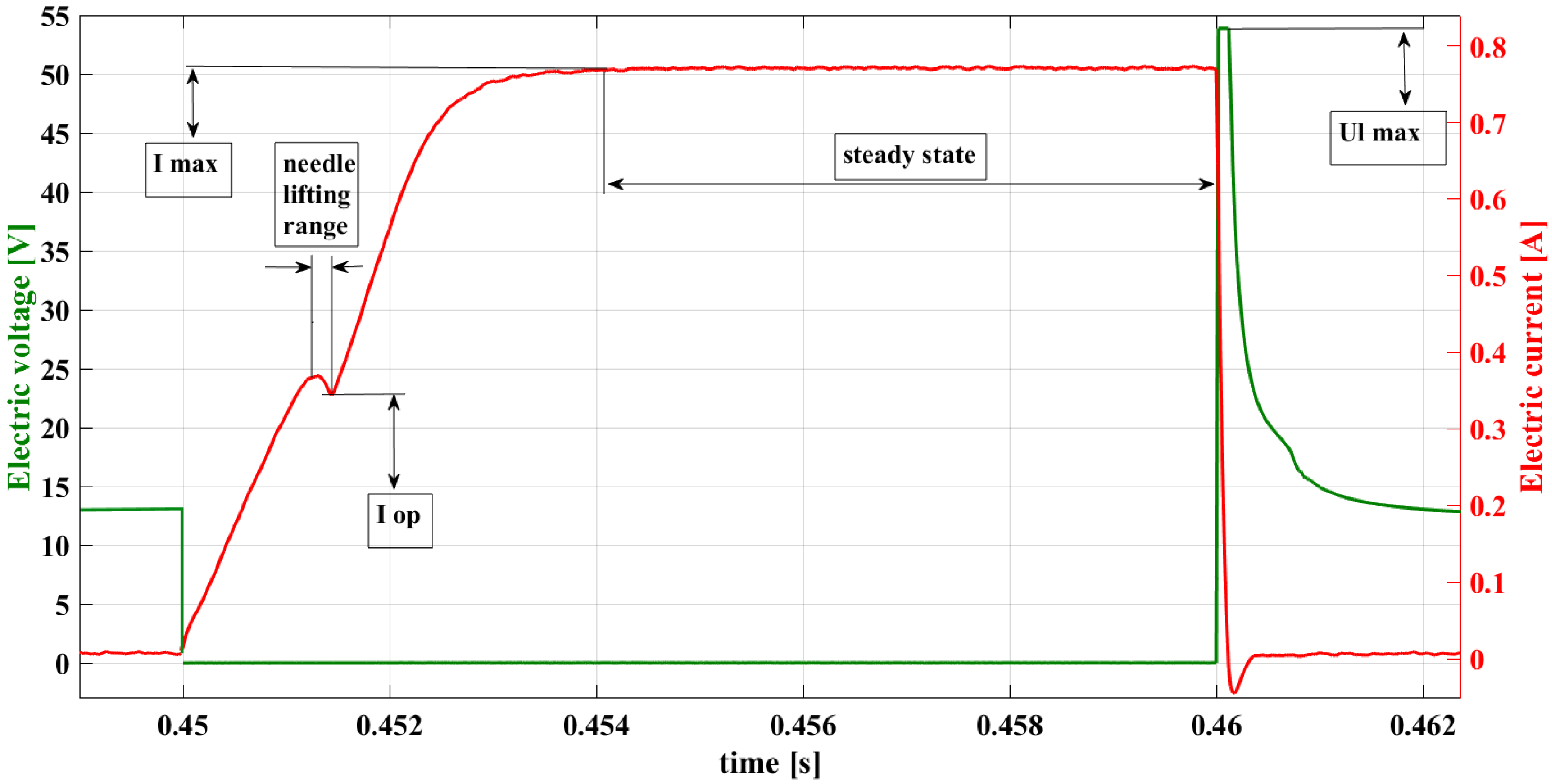
4. Assumptions of the Computational Algorithm
5. The Algorithm and the Computational Program
- -
- PWM—Pulse-Width Modulation [s];
- -
- —the delay time of the needle lifting point from the start [s];
- -
- Start/End—Steady-state start and end [s];
- -
- —value of electric current intensity in steady state (maximum) [A];
- -
- —value of electric voltage at the maximum of induction peak [V] and value occurrence phase [s];
- -
- —electric current intensity at the point of needle lifting [A] and value occurrence phase [s].
| PWM [s] | Delay in lifting the needle [s] | The time interval for achieving a constant electricity current value and the intensity value Start [s] - End [s] || Average value of the current intensity [A] | Maximum values of voltage peaks [V] for successive samples [V] | Electric current [A] at the point where the fuel flow is opened |
6. Example Calculation Results
- -
- Dark blue dotted line——value of electric current intensity in steady state (maximum) [A];
- -
- Black star——value of electric voltage at the maximum of induction peak [V];
- -
- Pink rhombus——electric current intensity at the point of needle lifting [A].
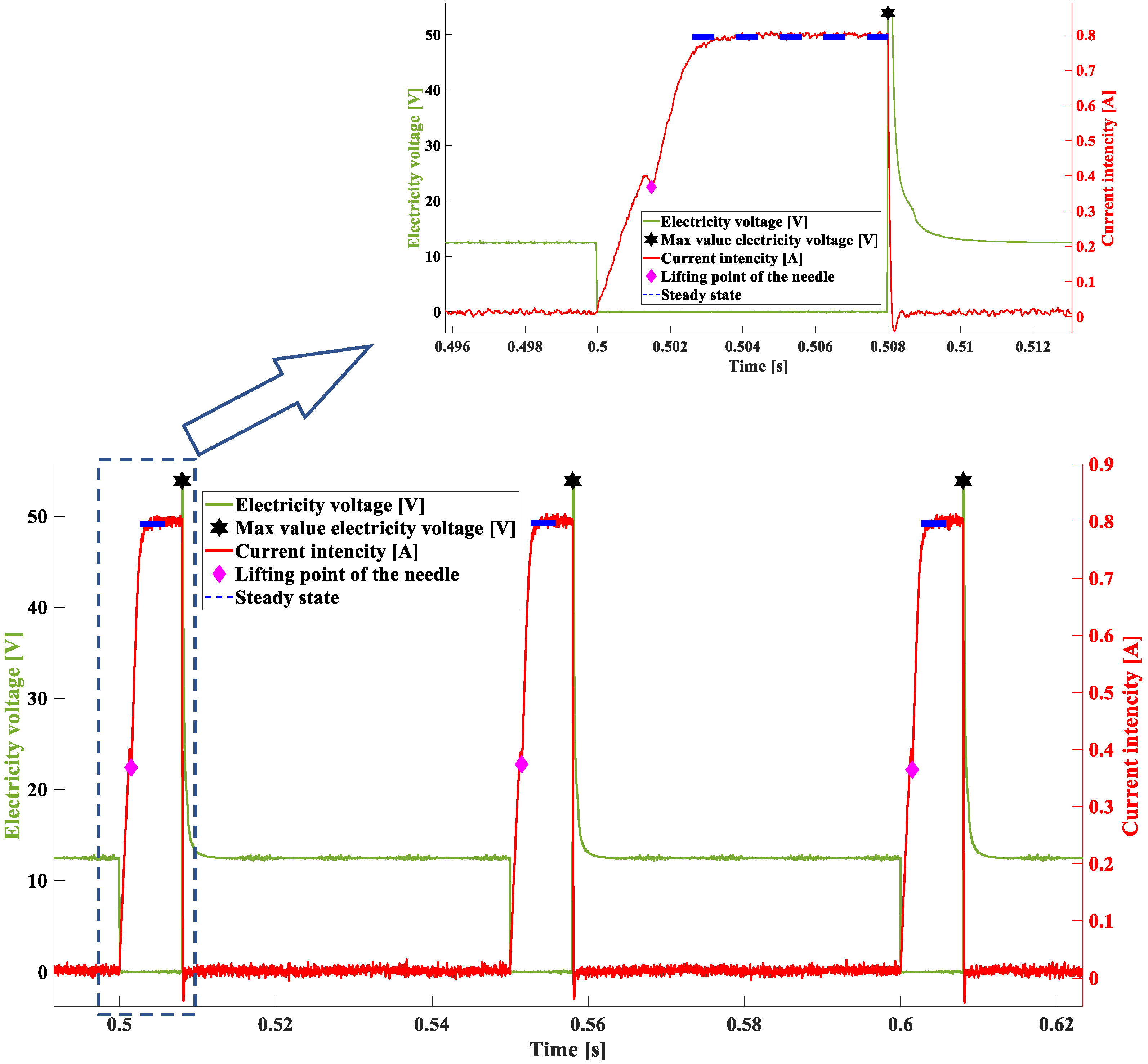
7. Discussion
8. Conclusions
Author Contributions
Funding
Institutional Review Board Statement
Informed Consent Statement
Data Availability Statement
Conflicts of Interest
References
- Hu, N.; Yang, J.; Zhou, P.; Hu, Y. Study of the impact of structural parameters on the dynamic response of an electronic fuel injector. Energy Convers. Manag. 2017, 136, 202–219. [Google Scholar] [CrossRef]
- Więcławski, K.; Mączak, J.; Szczurowski, K. Electric Current Waveform of the Injector as a Source of Diagnostic Information. Sensors 2020, 20, 4151. [Google Scholar] [CrossRef] [PubMed]
- Sun, P.; Xin, B.; Wang, X.; Zhang, H.; Long, L.; Wang, Q. Research on Correction of Flow Characteristics in Ballistic Zone of GDI Engine Injector. In Proceedings of the 2020 4th CAA International Conference on Vehicular Control and Intelligence (CVCI), Hangzhou, China, 18–20 December 2020; pp. 324–329. [Google Scholar] [CrossRef]
- Faralli, S.; Tozzetti, L.; Gambini, F.; Di Pasquale, F.; Izzo, I.; Barsanti, T.; Matteucci, L. Monitoring gasoline direct injectors for engine performance and emission control. In Proceedings of the 2019 AEIT International Conference of Electrical and Electronic Technologies for Automotive (AEIT AUTOMOTIVE), Turin, Italy, 2–4 July 2019; pp. 1–5. [Google Scholar] [CrossRef]
- Liuti, A. An Innovative Pressing Process by Mechanical Interference Fit for Assembly and Calibration of Fuel Injector. Ph.D. Dissertation, 130. Università Politecnica delle Marche, Ancona, Italy.
- Kubis, M.; Korenciak, D. Diagnostics of fuel systems in petrol vehicles. Transp. Res. Procedia 2021, 55, 988–994. [Google Scholar] [CrossRef]
- Denton, T. Automobile Electrical and Electronic Systems; Elsevier Butterworth-Heinemann: Oxford, UK, 2004; ISBN 0 7506 62190. [Google Scholar]
- Więcławski, K.; Mączak, J.; Szczurowski, K. Electric current as a source of information about control parameters of indirect injection fuel injector. Maint. Reliab. 2020, 22, 449–454. [Google Scholar] [CrossRef]
- Pielecha, I. Fuel injection rate shaping and its effect on spray parameters in a direct-injection gasoline system. J. Vis. 2022, 25, 727–740. [Google Scholar] [CrossRef]
- Bozhkov, S.; Milenov, I.; Slivarov, O.; Staneva, G.; Bozhkov, P. Researching the waveforms of the automobile electromagnetic actuators. Facta Univ. Ser. Autom. Control Robot. 2016, 1, 1–7. [Google Scholar]
- Beik, Y.; Dziewiątkowski, M.; Szpica, D. Exhaust Emissions of an Engine Fuelled by Petrol and Liquefied Petroleum Gas with Control Algorithm Adjustment. SAE Int. J. Engines 2020, 13, 739–760. [Google Scholar] [CrossRef]
- Rayapureddy, S.M.; Matijošius, J.; Rimkus, A.; Caban, J.; Słowik, T. Comparative Study of Combustion, Performance and Emission Characteristics of Hydrotreated Vegetable Oil–Biobutanol Fuel Blends and Diesel Fuel on a CI Engine. Sustainability 2022, 14, 7324. [Google Scholar] [CrossRef]
- Synák, F.; Synák, J.; Skrúcaný, T. Assessing the addition of hydrogen and oxygen into the engine’s intake air on selected vehicle features. Int. J. Hydrogen Energy 2021, 46, 31854–31878. [Google Scholar] [CrossRef]
- Fabiś, P.; Flekiewicz, M. Optimalisation of the SI engine timing advance fueled by LPG. Sci. J. Sil. Univ. Technol. Ser. Transp. 2021, 111, 33–41. [Google Scholar] [CrossRef]
- Caban, J.; Droździel, P.; Ignaciuk, P.; Kordos, P. The impact of changing the fuel dose on chosen parameters of the diesel engine start-up process. Transp. Probl. 2019, 14, 51–62. [Google Scholar] [CrossRef]
- Synák, F.; Synák, J.; Skrúcaný, T.; Milojević, S. Modification of engine control unit data and selected vehicle characteristics. Appl. Eng. Lett. 2019, 4, 120–127. [Google Scholar] [CrossRef]
- Hunicz, J.; Beidl, Ch.; Knost, F.; Münz, M.; Runkel, J.; Mikulski, M. Injection Strategy and EGR Optimization on a Viscosity-Improved Vegetable Oil Blend Suitable for Modern Compression Ignition Engines. SAE Tech. Pap. 2021, 3, 419–427. [Google Scholar] [CrossRef]
- Mane, Y.B.; Sawant, S.P. Software Design and Development of Engine Control Unit for Four Cylinder Petrol Engine, In Proceedings of the 2018 Fourth International Conference on Computing Communication Control and Automation (ICCUBEA). Pune, India, 16–18 August 2018; pp. 1–4. [Google Scholar] [CrossRef]
- Puškár, M.; Kopas, M.; Šoltésová, M.; Lavčák, M. System for analysis and correction of motor management. Sci. J. Sil. Univ. Technol. Ser. Transp. 2021, 111, 129–136. [Google Scholar] [CrossRef]
- Puškár, M.; Bigos, P.; Kelemen, M.; Tornhajzer, R.; Sima, M. Measuring method for feedback provision during development of fuel map in hexadecimal format for high-speed racing engines. Measurement 2016, 50, 203–212. [Google Scholar] [CrossRef]
- Dat, L.; Bradley, W.; Pietrzak, G.; Shaver, M. Dynamic surface control of a piezoelectric fuel injector during rate shaping. Control Eng. Pract. 2014, 30, 12–26. [Google Scholar] [CrossRef]
- Chao, W.; Guo-Xiu, L.; Zuo-Yu, S.; Lan, W.; Shu-Ping, S.; Jiao-Jiao, G.; Xiao-Jun, W. Effects of structure parameters on flow and cavitation characteristics within control valve of fuel injector for modern diesel engine. Energy Convers. Manag. 2016, 124, 104–115. [Google Scholar] [CrossRef]
- Salvador, F.J.; Martínez-López, J.; Caballer, M.; De Alfonso, C. Study of the influence of the needle lift on the internal flow and cavitation phenomenon in diesel injector nozzles by CFD using RANS methods. Energy Convers. Manag. 2013, 66, 246–256. [Google Scholar] [CrossRef]
- Vrublevskyi, O.; Wierzbicki, S. Measurement and theoretical analysis of the displacement characteristics of moving components in a solenoid injector in view of wave phenomena. Measurement 2022, 187, 110323. [Google Scholar] [CrossRef]
- Krajnák, J.; Homišin, J.; Grega, R.; Urbanský, M. The analysis of the impact of vibrations on noisiness of the mechanical system. Diagnostyka 2016, 17, 21–26. [Google Scholar]
- Czech, P. Diagnosing faults in the timing system of a passenger car spark ignition engine using the Bayes classifier and entropy of vibration signals. Sci. J. Sil. Univ. Technol. Ser. Transp. 2022, 116, 83–98. [Google Scholar] [CrossRef]
- Figlus, T.; Konieczny, Ł.; Burdzik, R.; Czech, P. The effect of damage to the fuel injector on changes of the vibroactivity of the diesel engine during its starting. Vibroengineering Procedia 2015, 6, 180–184. [Google Scholar]
- Figlus, T. The application of a continuous wavelet transform for diagnosing damage to the timing chain tensioner in a motorcycle engine. J. Vibroengineering 2015, 17, 1286–1294. [Google Scholar]
- Bejger, A.; Drzewieniecki, J.B. The Use of Acoustic Emission to Diagnosis of Fuel Injection Pumps of Marine Diesel Engines. Energies 2019, 12, 4661. [Google Scholar] [CrossRef]
- Merkisz-Guranowska, A.; Waligórski, M. Analysis of vibroacoustic estimators for a heavy-duty diesel engine used in sea transport in the aspect of diagnostics of its environmental impact. J. Vibroengineering 2016, 18, 1346–1357. [Google Scholar] [CrossRef]
- Dykasa, B.; Harris, J. Acoustic emission characteristics of a single cylinder diesel generator at various loads and with a failing injector. Mech. Syst. Signal Process. 2017, 93, 397–414. [Google Scholar] [CrossRef]
- Więcławski, K.; Mączak, J.; Szczurowski, K. Electric current characteristics of the injector generating fuel doses. Diagnostyka 2018, 19, 59–64. [Google Scholar] [CrossRef]
- Więcławski, K.; Figlus, T.; Mączak, J.; Szczurowski, K. Method of Fuel Injector Diagnosis Based on Analysis of Current Quantities. Sensors 2022, 22, 6735. [Google Scholar] [CrossRef]
- Bronshtein, I.N.; Semendyayev, K.A.; Musiol, G.; Mühlig, H. Handbook of Mathematics, 6th ed.; Springer-Verlag: Berlin/Heidelberg, Germany, 2015; ISBN 978-3-662-46220-1. [Google Scholar] [CrossRef]
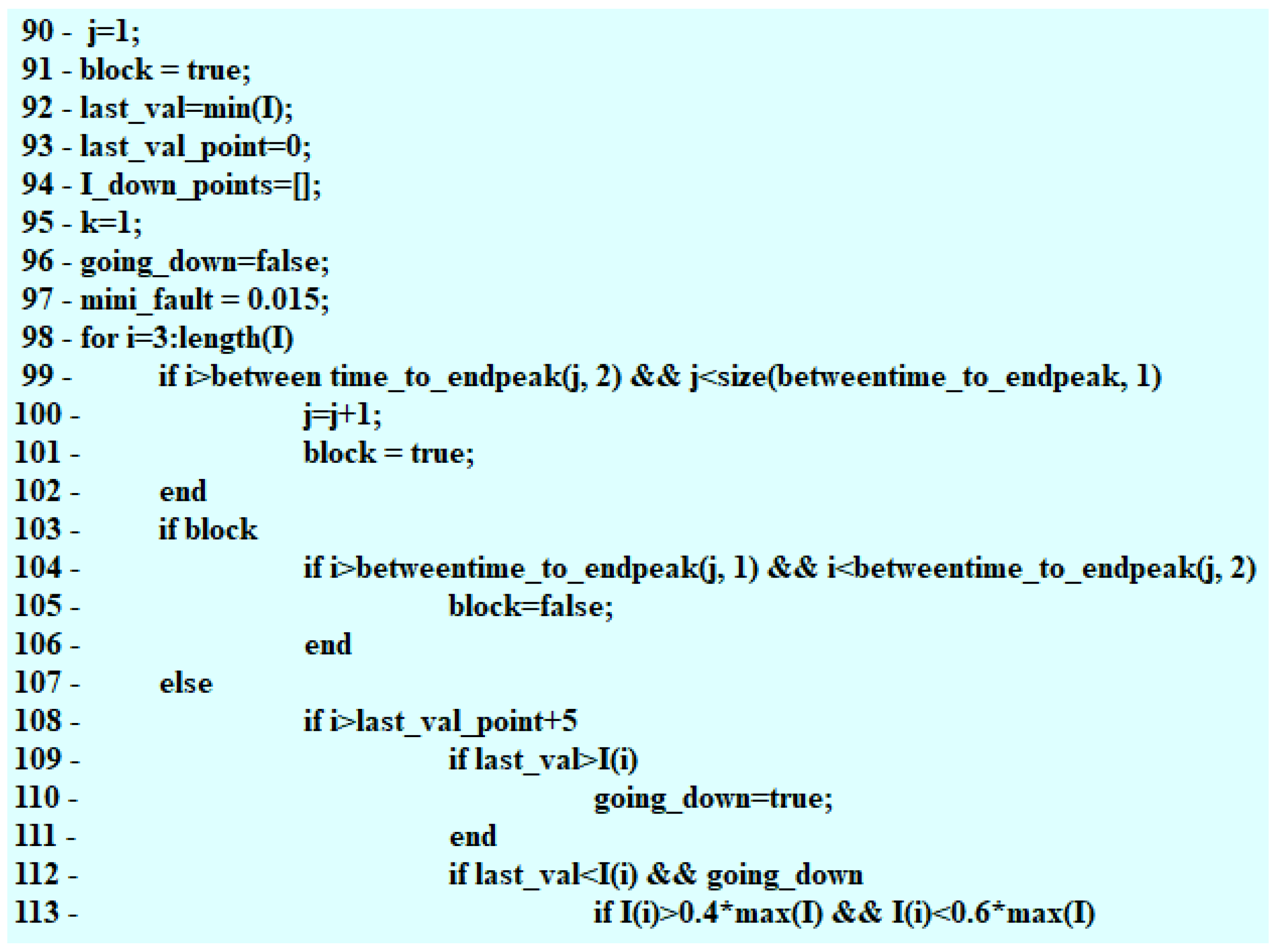

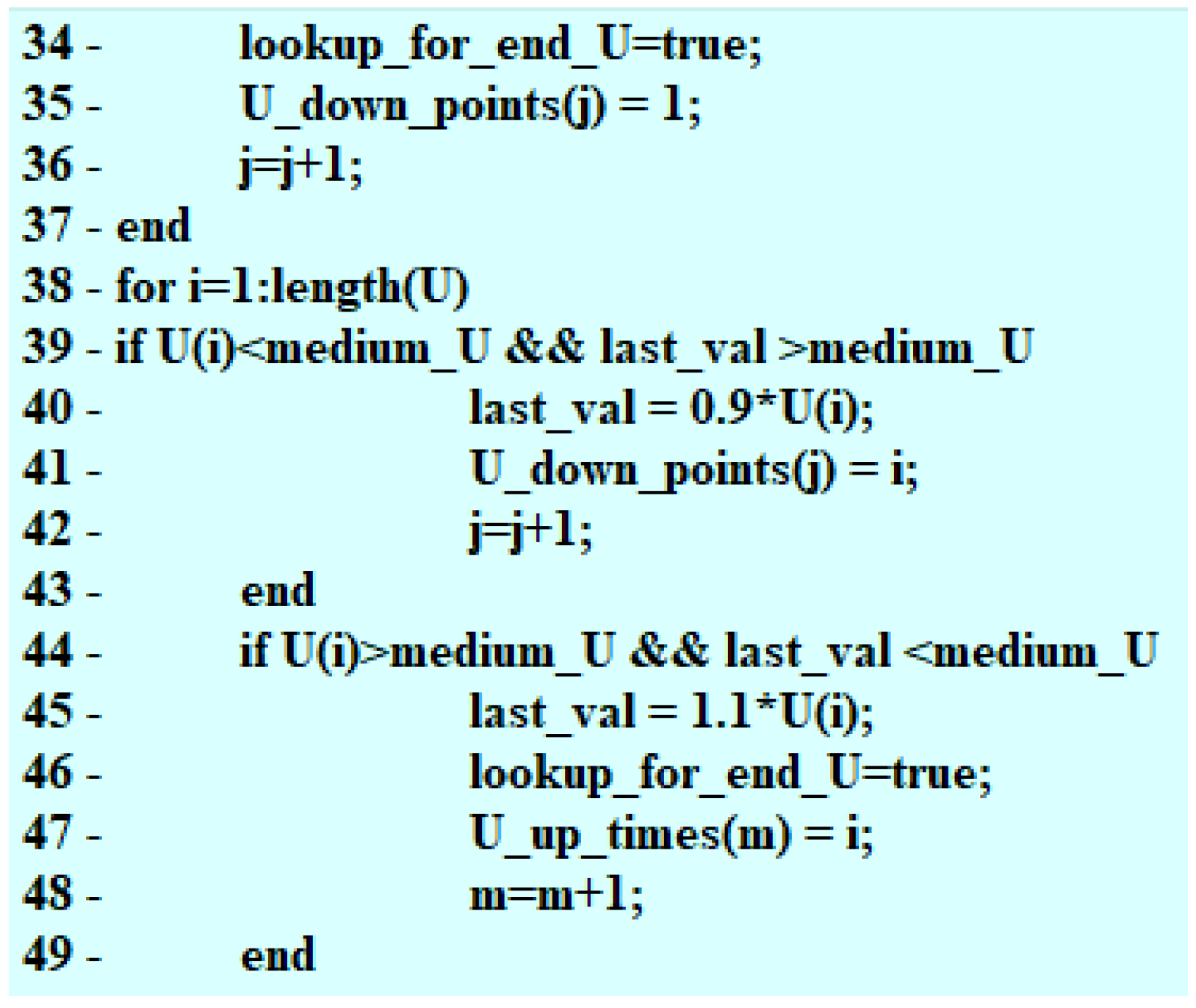
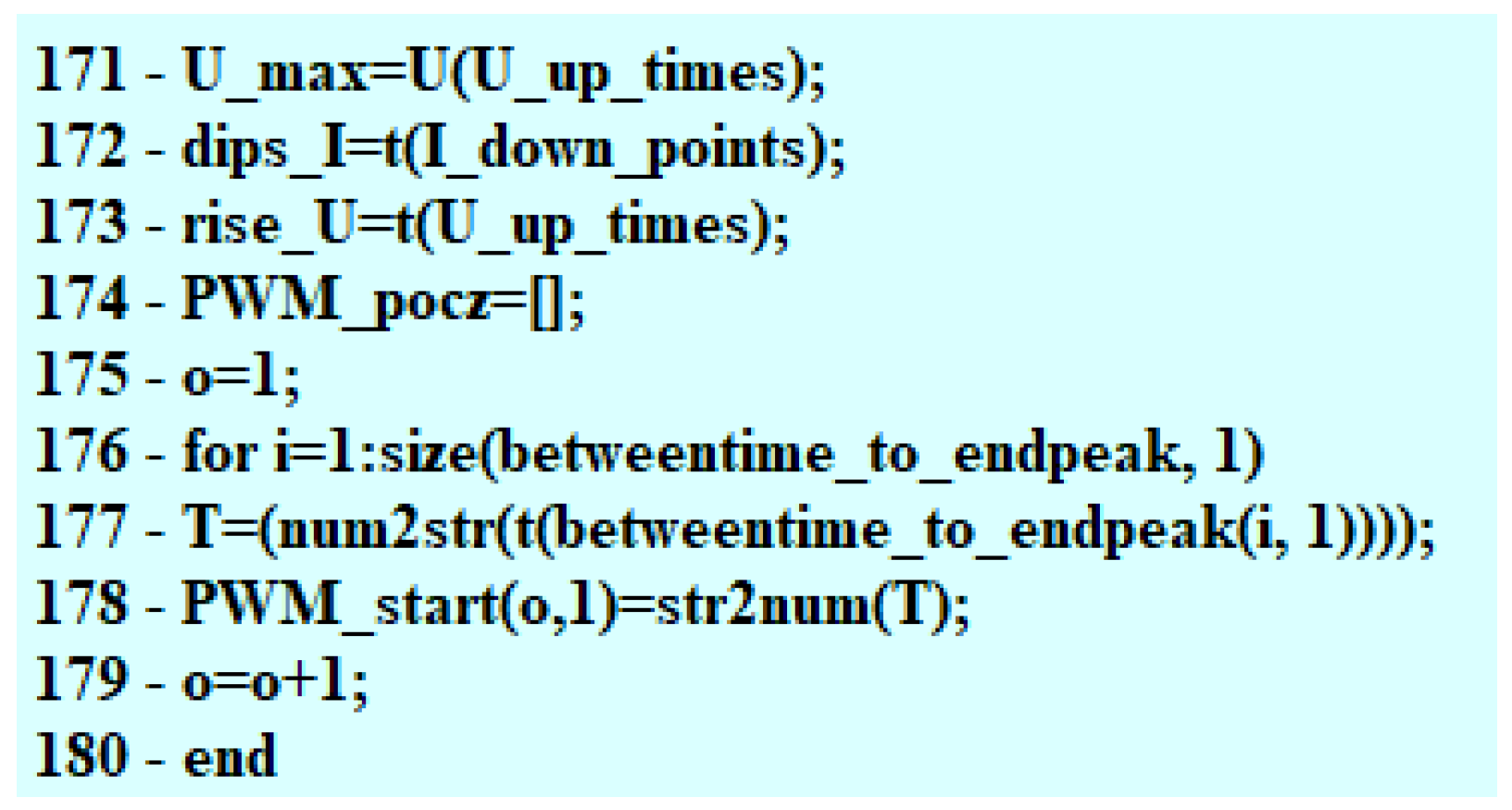

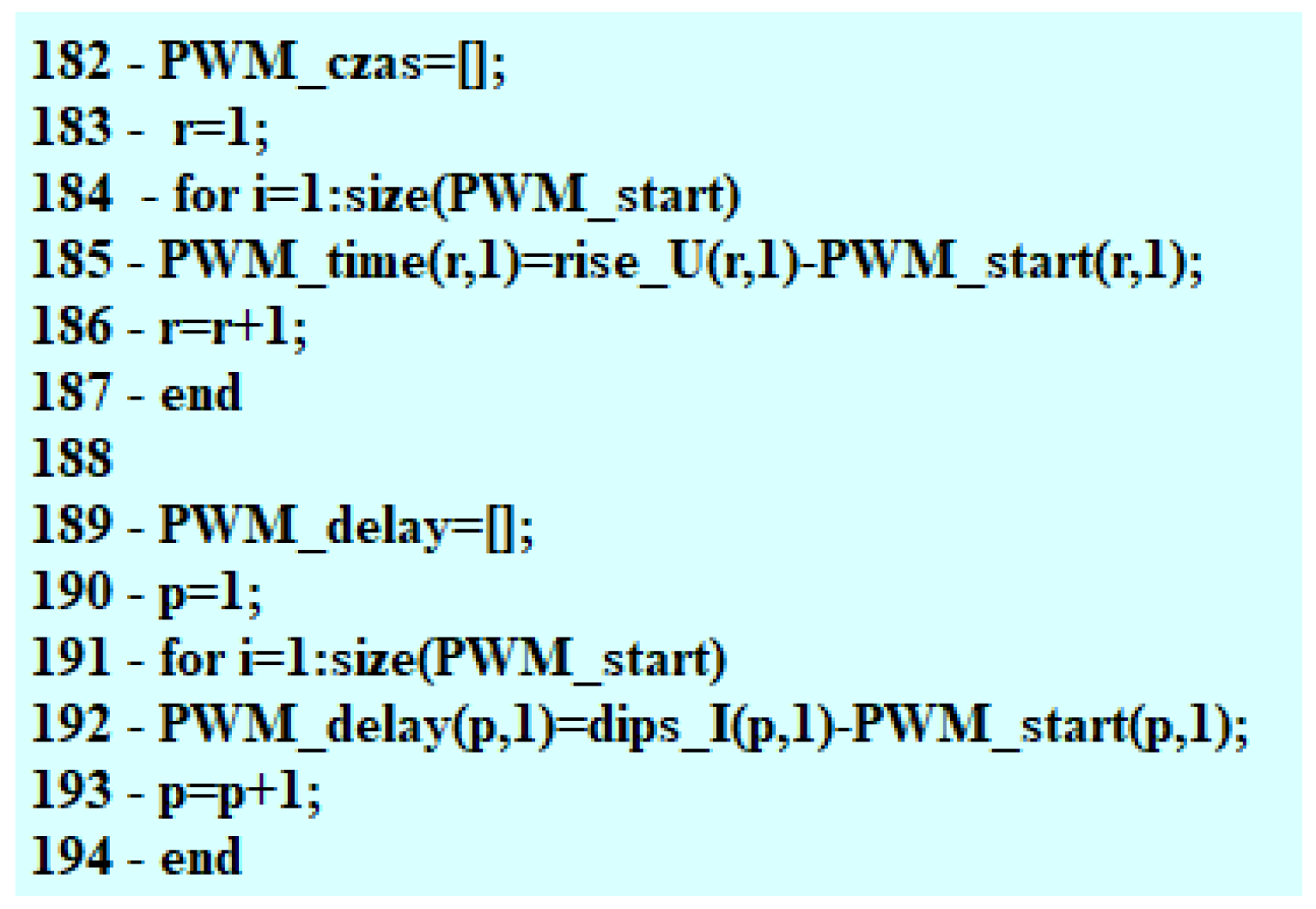


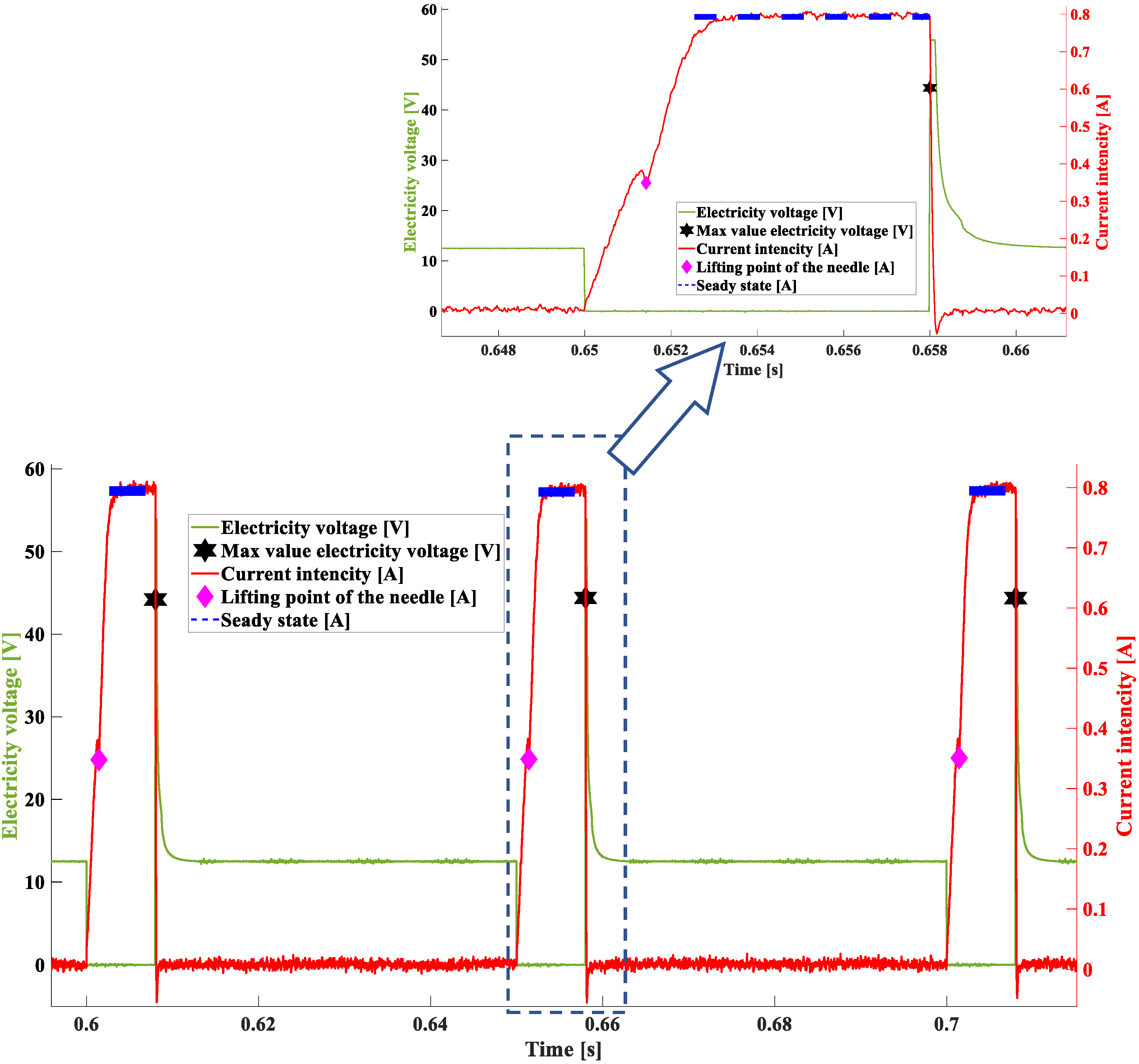
| PWM [s] | Delay in lifting the needle [s] | The time interval for achieving a constant electricity current value and the intensity value Start [s] - End [s] || Average value of the current intensity [A] | Maximum values of voltage peaks [V] for successive samples [V] | Electric current [A] at the point where the fuel flow is opened | |
 | 0.008 0.00802 0.00802 0.00802 0.00802 0.00802 0.00802 0.00802 0.00802 0.00802 0.00802 0.00802 0.00802 | 0.00148 0.0015 0.0015 0.0015 0.0015 0.00154 0.00152 0.0015 0.0015 0.00148 0.0015 0.00148 0.0015 | 0.00258 - 0.008 || 0.79389 0.0526 - 0.058 || 0.79554 0.10266 - 0.108 || 0.79497 0.15266 - 0.158 || 0.79572 0.20264 - 0.208 || 0.79462 0.2526 - 0.258 || 0.79531 0.30258 - 0.308 || 0.79415 0.35262 - 0.358 || 0.79614 0.40264 - 0.408 || 0.79414 0.45258 - 0.458 || 0.79529 0.5026 - 0.508 || 0.7945 0.55262 - 0.558 || 0.79674 0.60262 - 0.608 || 0.79531 | "53.885 for t=0.008" "53.885 for t=0.058" "53.885 for t=0.108" "53.885 for t=0.158" "53.885 for t=0.208" "53.885 for t=0.258" "53.885 for t=0.308" "53.885 for t=0.358" "53.885 for t=0.408" "53.885 for t=0.458" "53.885 for t=0.508" "53.885 for t=0.558" "53.885 for t=0.608" | "0.36435 for t=0.00148" "0.37111 for t=0.05148" "0.36918 for t=0.10148" "0.36532 for t=0.15148" "0.37015 for t=0.20148" "0.37691 for t=0.25152" "0.36532 for t= 0.3015" "0.37401 for t=0.35148" "0.36242 for t=0.40148" "0.36918 for t=0.45146" "0.36822 for t=0.50148" "0.37401 for t=0.55146" "0.36435 for t=0.60148" |
| PWM [s] | Delay in lifting the needle [s] | The time interval for achieving a constant electricity current valueand the intensity value Start [s] - End [s] || Average value of the current intensity [A] | Maximum values of voltage peaks [V] for successive samples [V] | Electric current [A] at the point where the fuel flow is opened | |
 | 0.004 0.00402 0.00402 0.00402 0.00402 0.00402 0.00402 | 0.00156 0.00158 0.00154 0.00158 0.00158 0.00158 0.00158 | 0.00256 - 0.004 || 0.80115 0.05258 - 0.054 || 0.80561 0.10252 - 0.104 || 0.80095 0.15258 - 0.154 || 0.80691 0.20264 - 0.204 || 0.80354 0.25258 - 0.254 || 0.80426 0.3025 - 0.304 || 0.80047 | "53.885 for t=0.004" "53.885 for t=0.054" "53.885 for t=0.104" "53.885 for t=0.154" "53.885 for t=0.204" "53.885 for t=0.254" "53.885 for t=0.304" | "0.40301 for t=0.00156" "0.39238 for t=0.05156" "0.39431 for t=0.10152" "0.38754 for t=0.15156" "0.38947 for t=0.20156" "0.39721 for t=0.25156" "0.39817 for t=0.30156" |
| PWM [s] | Delay in lifting the needle [s] | The time interval for achieving a constant electricity current value and the intensity value Start [s] - End [s] || Average value of the current intensity [A] | Maximum values of voltage peaks [V] for successive samples [V] | Electric current [A] at the point where the fuel flow is opened | |
 | 0.008 0.008 0.008 0.008 0.008 0.008 0.008 0.008 0.008 0.008 0.008 0.008 0.008 0.008 0.008 | 0.00144 0.00142 0.00142 0.00142 0.00142 0.00142 0.00144 0.00142 0.00142 0.00142 0.00144 0.00142 0.00144 0.00142 0.00144 | 0.00272 - 0.008 || 0.79558 0.05254 - 0.058 || 0.79255 0.10258 - 0.108 || 0.79449 0.1526 - 0.158 || 0.79299 0.20268 - 0.208 || 0.79562 0.25262 - 0.258 || 0.79331 0.30254 - 0.308 || 0.79466 0.35256 - 0.358 || 0.79319 0.40264 - 0.408 || 0.79441 0.45256 - 0.458 || 0.79243 0.5026 - 0.508 || 0.79415 0.55258 - 0.558 || 0.79267 0.60264 - 0.608 || 0.79428 0.65254 - 0.658 || 0.79298 0.7026 - 0.708 || 0.79471 | "44.4667 for t=0.008" "44.3927 for t=0.058" "44.4042 for t=0.108" "44.5291 for t=0.158" "44.5209 for t=0.208" "44.35 for t=0.258" "44.304 for t=0.308" "44.4847 for t=0.358" "44.378 for t=0.408" "44.4207 for t=0.458" "44.5307 for t=0.508" "44.3517 for t=0.558" "44.189 for t=0.608" "44.3878 for t=0.658" "44.3599 for t=0.708" | "0.35372 for t=0.00144" "0.35372 for t=0.05142" "0.34599 for t=0.10142" "0.35179 for t=0.15142" "0.35469 for t=0.20142" "0.34889 for t=0.25142" "0.34986 for t=0.30144" "0.35275 for t=0.35142" "0.34792 for t=0.40142" "0.34405 for t=0.45142" "0.34986 for t=0.50144" "0.35469 for t=0.55142" "0.34792 for t=0.60144" "0.34889 for t=0.65142" "0.35082 for t=0.70144" |
Publisher’s Note: MDPI stays neutral with regard to jurisdictional claims in published maps and institutional affiliations. |
© 2022 by the authors. Licensee MDPI, Basel, Switzerland. This article is an open access article distributed under the terms and conditions of the Creative Commons Attribution (CC BY) license (https://creativecommons.org/licenses/by/4.0/).
Share and Cite
Więcławski, K.; Antkowiak, M.; Figlus, T. Recognizing Significant Components of Electrical Waveforms of Actuators Operated by Vehicle Controllers. Sensors 2022, 22, 7945. https://doi.org/10.3390/s22207945
Więcławski K, Antkowiak M, Figlus T. Recognizing Significant Components of Electrical Waveforms of Actuators Operated by Vehicle Controllers. Sensors. 2022; 22(20):7945. https://doi.org/10.3390/s22207945
Chicago/Turabian StyleWięcławski, Krzysztof, Maja Antkowiak, and Tomasz Figlus. 2022. "Recognizing Significant Components of Electrical Waveforms of Actuators Operated by Vehicle Controllers" Sensors 22, no. 20: 7945. https://doi.org/10.3390/s22207945
APA StyleWięcławski, K., Antkowiak, M., & Figlus, T. (2022). Recognizing Significant Components of Electrical Waveforms of Actuators Operated by Vehicle Controllers. Sensors, 22(20), 7945. https://doi.org/10.3390/s22207945






